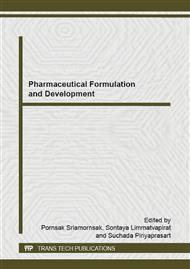p.133
p.137
p.141
p.145
p.151
p.155
p.159
p.164
p.168
Comparison of Solvent Miscibility of Coconut Oil and its Modified Forms
Abstract:
Solvent miscibility is an important parameter for dosage form design, especially for liquid preparations. The purpose of this study was to investigate the polarity change of coconut oil (CO) after modification by glycerolysis and its consequence on solvent miscibility. Coconut oil and its modified form were separately mixed with various solvents which had different dielectric constant and then determined for their miscibility. The thin layer chromatography (TLC) was also used to clarify the composition of coconut oil and its modified form. The result indicated that coconut oil and modified coconut oil (MCO) were miscible with low polarity solvent having the dielectric constant from 1.94 to 21.5 (from hexane to acetone) and were immiscible with high polarity solvents possessing the dielectric constant over 42.5. However, MCO demonstrated miscibility with ethanol, propylene glycol and methanol (dielectric constant 24.5, 32.1, 32.7) while coconut oil did not compatible with those solvents. The result suggested the polarity increment of MCO after glycerolysis. The presence of high polar compounds, including monolaurin and lauric acid in MCO was later clarified by TLC. In conclusion, the knowledge gained from this research may provide the preliminary data for formulation of MCO into suitable liquid dosage form in the near future.
Info:
Periodical:
Pages:
151-154
Citation:
Online since:
December 2014
Keywords:
Price:
Сopyright:
© 2015 Trans Tech Publications Ltd. All Rights Reserved
Share:
Citation:


